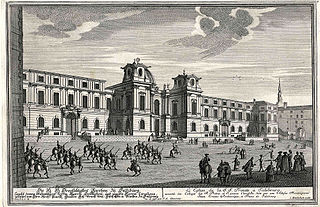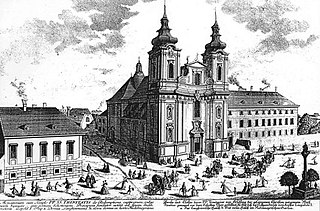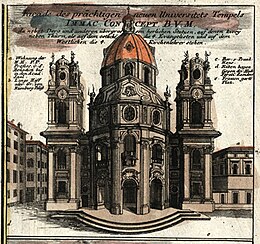
Great Mass in C minor, K. 427/417a, is the common name of the musical setting of the mass by Wolfgang Amadeus Mozart and considered one of his greatest works. He composed it in Vienna in 1782 and 1783 after his marriage when he moved to Vienna from Salzburg. This large-scale work, a missa solemnis, is scored for two soprano soloists, a tenor and a bass, double chorus and large orchestra. It remained unfinished, missing large portions of the Credo and the complete Agnus Dei.

The Missa Sancti Bernardi von Offida is a mass in B-flat major by Joseph Haydn, Hob. XXII:10, Novello 1, was written the same year as the Missa in tempore belli (1796), and it "may have been the first mass Haydn wrote after his return from England." Yet it may also have been the second. It is usually given as Haydn's ninth setting of the mass, though its Hoboken number is XXII:10. This mass was written in honor of St. Bernard of Offida, a Capuchin monk who devoted himself to helping the poor; a century after the monk's death, he was beatified by Pope Pius VI.

The Missa Cellensis in honorem Beatissimae Virginis Mariae in C major by Joseph Haydn, Hob. XXII:5, Novello 3, was originally written in 1766, after Haydn was promoted to Kapellmeister at Eszterháza following the death of Gregor Joseph Werner. The original title as it appears on the only surviving fragment of Haydn's autograph score, that has been discovered around 1970 in Budapest, clearly assigns the mass to the pilgrimage cult of Mariazell, Styria. Until that discovery, the work was known as Missa Sanctae Caeciliae, or in German Cäcilienmesse, a title probably attributed to the mass in the 19th century. Whether the alternative title refers to a performance of the piece by the St. Cecilia's Congregation, a Viennese musician's fraternity, on some St. Cecilia's day, as has been suggested, remains speculation.

The Missa brevis No. 9 in B-flat major by Wolfgang Amadeus Mozart, K. 275/272b, was probably written before September 1777 for Salzburg. The mass is scored for SATB soloists, SATB choir, violin I, violin II, 3 trombones, string bass, and organ.

The Missa brevis in G major, K. 140, K3 Anh. 235d, K6 Anh. C 1.12, was probably composed by Wolfgang Amadeus Mozart shortly after returning to Salzburg, in March 1773, from his third trip to Italy.
Michael Haydn's Missa Hispanica or Missa a due cori, Klafsky I:17, MH 422, was presumably written for Spain, but there is no evidence of its ever having been performed there during Haydn's lifetime. The mass is scored for 2 oboes, 2 bassoons, 2 horns in low C, F and G, 2 trumpets in C, timpani, strings, basso continuo, SATB soloists, and two mixed choirs.
Michael Haydn completed the Missa in honorem Sanctae Ursulae, Klafsky 1:18, MH 546, on August 5, 1793, probably for use at the ceremony in which Ursula Oswald, the daughter of a friend, professed her religious vows at the Benedictine Abbey of Frauenwörth Chiemsee. Because of that fact, the Mass is sometimes known as the Chiemsee Mass.

The St. Francis Mass is the shorter name for the Missa sub titulo Sancti Francisci Seraphici composed by Michael Haydn. He completed it on 16 August 1803, apparently at the request of Empress Maria Theresa for a name day celebration.

The Missa brevis No. 8 in C major, K. 259, is a mass composed by Wolfgang Amadeus Mozart in 1776. It is scored for SATB soloists, SATB choir, violin I and II, 2 oboes, 2 clarini, 3 trombones colla parte, timpani and basso continuo.

The Missa in honorem Sanctissimae Trinitatis in C major, K. 167, is a mass composed by Wolfgang Amadeus Mozart in June 1773. It is scored for SATB choir, violin I and II, 2 oboes, 2 clarini, 2 trumpets, timpani and basso continuo.

The Credo Mass in C major, K. 257, is a mass composed by Wolfgang Amadeus Mozart in 1776. It is scored for SATB soloists, SATB choir, violin I and II, 2 oboes, 2 clarini, 3 trombones colla parte and basso continuo.

The Missa solemnis in C major, K. 66, is a mass composed by Wolfgang Amadeus Mozart in 1769. It is scored for SATB soloists and choir, violins I and II, viola, 2 oboes, 2 horns, 2 clarini, 2 trumpets and basso continuo.

The Missa brevis in D major, K. 194/186h, is a mass composed by Wolfgang Amadeus Mozart and completed on 8 August 1774. It is scored for SATB soloists, SATB choir, violin I and II, 3 trombones colla parte, and basso continuo.

The Missa brevis No. 7 in C major, K. 258, is a mass composed by Wolfgang Amadeus Mozart in 1776. It is scored for SATB soloists, SATB choir, violin I and II, 2 oboes, 2 clarini, 3 trombones colla parte, timpani and basso continuo.

The Missa longa in C major, K. 262/246a, is a mass composed by Wolfgang Amadeus Mozart in May 1776. Other sources claim it was composed in May 1775. It is scored for SATB soloists, SATB choir, violin I and II, 2 oboes, 2 horns, 2 clarini, 3 trombones colla parte, timpani and basso continuo.

Mozart's Mass in G major, K. 49/47d), is his first full mass. It is a missa brevis scored for SATB soloists and choir, violin I and II, viola, and basso continuo.

Mass No. 4 in C major, D 452, is a mass composed by Franz Schubert in 1816. It was originally scored for soprano, alto, tenor and bass soloists, SATB choir, violin I and II, and basso continuo. It is classified as a missa solemnis.

Mass No. 5 in A-flat major, D 678, is a mass composed by Franz Schubert, completed in 1822. There is no record of a performance during Schubert's lifetime. It is scored for soprano, alto, tenor and bass soloists, SATB choir with divisi, violin I and II, viola, flute, 2 oboes, 2 clarinets, 2 bassoons, 2 horns, 2 trumpets, 3 trombones colla parte, timpani and basso continuo. It is classified as a missa solemnis.

Mass No. 6 in E-flat major, D 950, is a mass composed by Franz Schubert. It is scored for two tenor soloists, soprano, alto and bass soloists, SATB choir with divisi, 2 oboes, 2 clarinets, 2 bassoons, 2 horns, 2 trumpets, 3 trombones, timpani, violin I and II, viola, cello, and double bass. It was Schubert's final setting of the order of Mass, and is classified as a missa solemnis.
Missa Sancti Nicolai, Mass No. 6 in G major, Hob. XXII/6, also known as the Nicolaimesse, is a mass by Joseph Haydn, composed around 1772 and revised in 1802.













